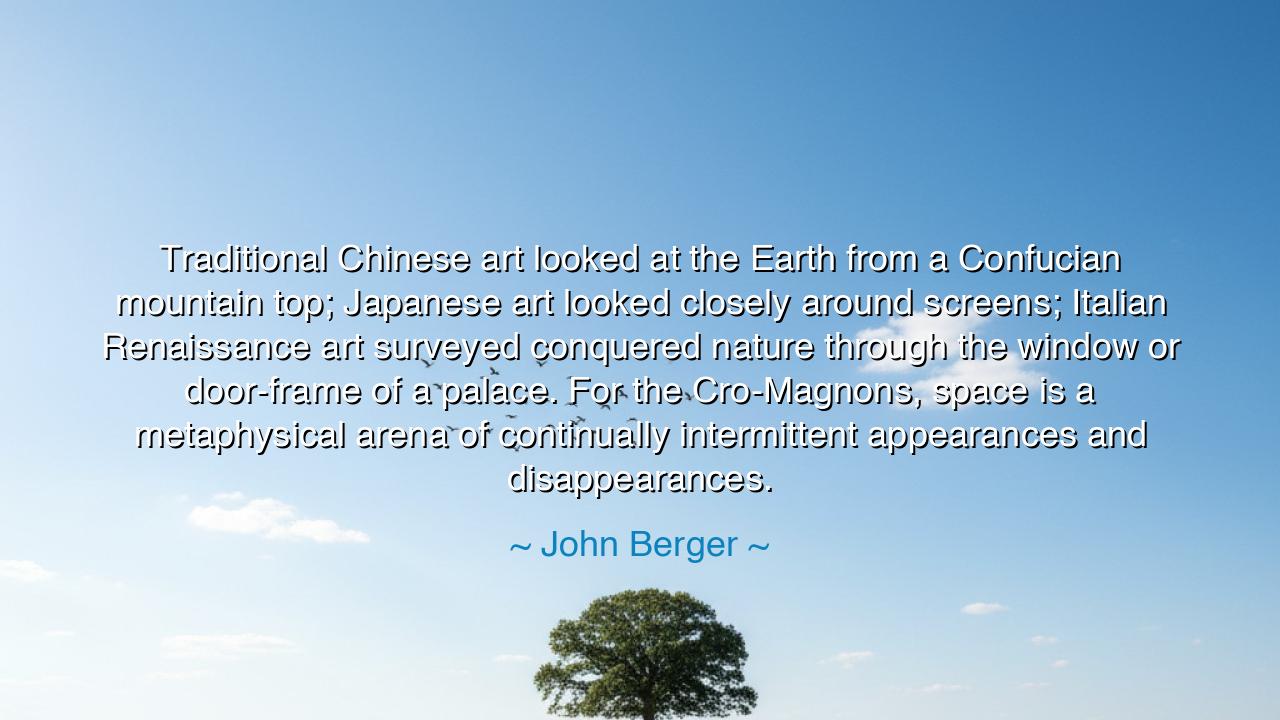
Traditional Chinese art looked at the Earth from a Confucian
Traditional Chinese art looked at the Earth from a Confucian mountain top; Japanese art looked closely around screens; Italian Renaissance art surveyed conquered nature through the window or door-frame of a palace. For the Cro-Magnons, space is a metaphysical arena of continually intermittent appearances and disappearances.






In the sacred act of creation, there is a profound understanding that every civilization sees the world in its own unique way, shaping its art and perception of nature. In his words, John Berger offers us a glimpse into the depth of this vision: "Traditional Chinese art looked at the Earth from a Confucian mountain top; Japanese art looked closely around screens; Italian Renaissance art surveyed conquered nature through the window or door-frame of a palace. For the Cro-Magnons, space is a metaphysical arena of continually intermittent appearances and disappearances." These words reveal not only the diverse perspectives of humanity but also the spiritual and philosophical underpinnings that shape our view of the world.
The Chinese, influenced by the teachings of Confucius, saw the world from a lofty, detached perspective, as though observing it from the summit of a great mountain. This elevated view is symbolic of Confucianism, which stresses harmony, balance, and the proper relationship between humans, nature, and the cosmos. In Chinese art, the landscape is not just a physical place, but a realm imbued with spiritual significance, a space for reflection, meditation, and the unfolding of the natural order. The mountain is revered not just for its grandeur but as a symbol of wisdom—a place from which to observe the workings of the world in its most ideal form, untouched and serene.
In contrast, Japanese art brings us down from the heights, focusing on the intimate and the immediate. As Berger suggests, Japanese art looked closely, often framed by the sliding screens that divide the spaces of a room, creating a sense of containment and reflection. The screen, both a physical and symbolic boundary, invites the viewer to examine the world in all its detail. Where the Chinese artist might have looked at the vastness of nature, the Japanese artist focused on the minute, the ephemeral, and the impermanent—capturing the beauty of the passing seasons, the transient nature of life itself. This perspective, shaped by Zen and Buddhism, finds beauty not in grandiose landscapes, but in the quiet simplicity of everyday life, where each moment of existence is seen as part of a continuous and interconnected whole.
The Italian Renaissance, with its grand palaces and conquered nature, reflects yet another approach. Berger notes that Italian artists observed nature through the window or door-frame of a palace—a frame that divides the world into the controlled and the uncontrolled, the civilized and the wild. This framing was not only a literal act of perspective but also a symbolic gesture, as Renaissance thinkers sought to conquer and understand the natural world through the lens of reason and science. The Renaissance was a period of discovery, of surveying the landscape and mapping it, both literally and metaphorically. It was a time when humanity sought to place itself in the center of the universe, viewing nature as something to be ordered, measured, and ultimately mastered.
Then, there are the Cro-Magnons, whose understanding of space was far more mystical, as Berger suggests. For these early humans, space was a metaphysical arena, where the world was not something to be controlled or understood through intellect, but something that appeared and disappeared in cycles—a place of mystery, where life and death, creation and destruction, are in a constant state of flux. The cave paintings they left behind—these early expressions of art—speak to a worldview that was deeply connected to nature and the spirits of the animals they hunted. The world was not a place to be surveyed from a mountain or through a frame, but a dynamic and uncertain realm in which humans were both observers and participants, caught between the physical and the spiritual, the tangible and the elusive.
From these various views of space, nature, and existence, we are reminded that perspective shapes our understanding of the world. Each culture’s art reflects its values, its philosophy, and its relationship with the natural world. Whether from the detached height of the Chinese mountain, the intimate space of the Japanese screen, the controlled palace windows of the Renaissance, or the mystical realm of the Cro-Magnons, we see that the world is a canvas, painted with the hues of human understanding and spiritual reflection. These diverse views all offer wisdom for us today, reminding us of the importance of perspective in shaping how we engage with the world.
The lesson here is simple yet profound: the way we perceive the world, our connection to nature, and our place within the larger cosmos influences how we live, how we create, and how we understand our lives. It is not enough to look at the world through a single lens. We must seek to expand our view, to see through the frames of other cultures, other traditions, and other ways of thinking. By doing so, we gain a richer, more complex understanding of the world and our place in it. Let us, like the artists of old, create from the many perspectives that surround us, blending them into a harmonious vision of life, where all things—whether grand or small—are part of the same beautiful whole.






AAdministratorAdministrator
Welcome, honored guests. Please leave a comment, we will respond soon